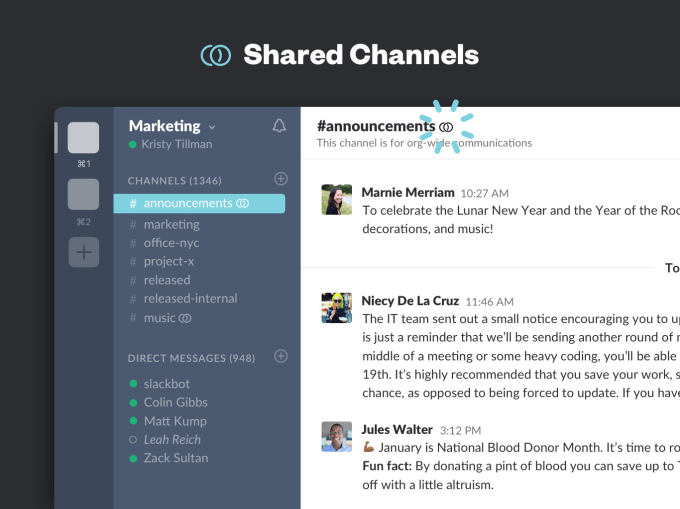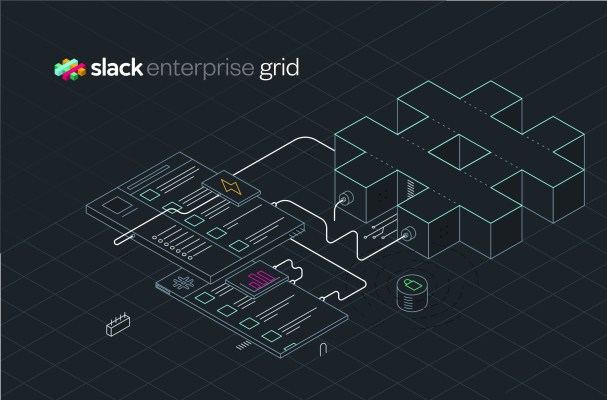Slack, the business app that lets teams of users communicate, share files from other services, and work on them with each other, has taken off like wildfire since launching three years ago, with 5 million daily users, 1.5 million of them paying today. Now, Slack is embarking on the next step in its ambition to be the go-to platform for all workplace collaboration, no matter how big the company may be.
(Or up to 500,000 employees, to be more specific.)
Today, the eponymous company behind the app is today launching Enterprise Grid — a new product aimed at corporates and other very large enterprises.

Enterprise Grid has been in the works for over a year, and it is potentially Slack’s most ambitious move yet. It will include not just an enterprise-grade version of Slack, with an unlimited number of workspaces, but some new features that will take Slack, for the first time, into a whole new area in terms of where it sits in a business.
A new set of search, business intelligence and analytics tools — which are not launching today but plan to be rolled out later in the year — will give users the ability to look for files across the whole of their system, and and also suggest content and contacts to users, positioning Slack as a platform to interact across the whole knowledge base of your company.
The new version goes live today, and to kick it off, Slack is announcing some initial customers: financial services giant Capital One, Paypal and IBM.
IBM is a particularly interesting name to see here, given that it sells its own collaboration product for large enterprises, IBM Connections, and it is also working on what appears to be its own AI business intelligence product, Watson Workspace. Other would be competitors include Workplace from Facebook, Microsoft’s Teams, Jive and Spark from Cisco.
Enterprise Grid, as you would expect, comes with a range of features that are essentially table stakes in the enterprise software market.
IT administrators are now be able to manage and provision multiple large teams; and, in addition to the encryption that Slack already offers, add in new layers of security and identity management (integrating with Okta, OneLogin, Ping Identity/Federate, MSFT Azure, Bitium, LastPass, Centrify, Clearlogin and Auth0); set new security and compliance controls; and new HIPAA & FINRA compliance and data loss prevention integration (working withPaloAlto Networks, Bloomberg Vault, Skyhigh, Netskope, Relativity by KCura and Smarsh, among others).
Along with this, Slack is also adding in new partnership with SAP where the enterprise services company is building a portfolio of bots to integrate with SAP services. The first three will be a Concur travel and expense bot; a SuccessFactors performance management bot; and a bot to interact with the HANA Cloud platform.
This expands on the kids of relationships Slack already has in place with other B2B businesses like Salesforce and Google Cloud, and it looks like these SAP bots will work across all of Slack, rather than just for users of Enterprise Grid.
You may wonder what Slack means by calling its product “Grid”. The concept here seems to be one of creating federations of teams that can then interlink workspaces with each other when and where they have to but also work independently of each other to remain efficient. (The logic here is that if a business has thousands of users, you wouldn’t have a place where all of them communicated, it would be too noisy.)
“We wanted to give Slack the flexibility to work as teams, but they were still falling back to email when they worked with each other,” April Underwood, Slack’s VP of product, said in an event today where Slack debuted Grid.
Today, when you create channels in normal Slack, anyone can add people from your team to the channel. In Grid, the idea here is that each team will have an administrator who will be given the option to do this. Ultimately, IT administrators will be able to control what each of these secondary administrators are able to provision, including linking teams together.
While there are already hundreds of thousands of users from large organizations and businesses who are already using the earlier version of Slack — all three of the Grid customers getting announced today were among them — it will be interesting to see how many of these will covert into using the more expensive and more controlled Enterprise Grid.
Underwood told me that for now, Slack will be selling the product directly to customers and working with them to integrate, and that it has not yet selected to work with any systems integrators, one channel that is often used to help sell and build software into corporate IT systems.
Alan Lepofsky, an analyst with Constellation Research, also suggested that something else Slack will need to do is to create a more targeted vertical focus to improve its credibility with individual segments.
“Slack needs to improve its industry vertical focus,” he said. “They need to show prospects in pharma, finance, and manufacturing that they understand their specific needs verses just producing a one-size-fits-all tool. That’s not just in product features, but in sals cycle, support and other facets of the relationship.”
Pricing for Enterprise Grid — unlike normal Slack, where pricing starts at $8 and $15 per month for two tiers — is not being disclosed: those who are interested in the product need to apply directly to the company.
